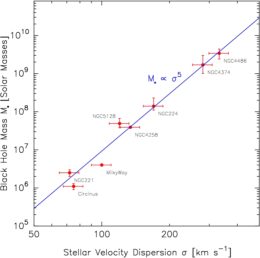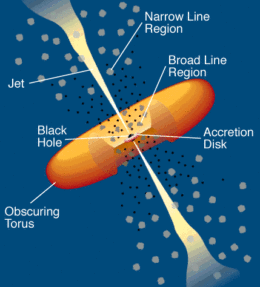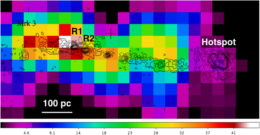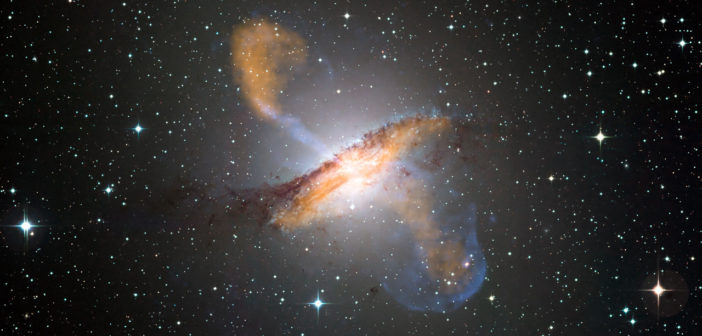How do the supermassive black holes that live at the centers of galaxies influence their environments? New observations of a distant active galaxy offer clues about this interaction.
Signs of Coevolution

Plot demonstrating the m-sigma relation, the empirical correlation between the stellar velocity dispersion of a galactic bulge and the mass of the supermassive black hole at its center. [Msigma]
One proposed source of this coupling is the powerful jets emitted from the poles of these supermassive black holes. These jets are thought to be produced as some of the material accreting onto the black hole is flung out, confined by surrounding gas and magnetic fields. Because the jets of hot gas and radiation extend outward through the host galaxy, they provide a means for the black hole to influence the gas and dust of its surroundings.

In our current model of a radio-loud active galactic nuclei, a region of hot, ionized gas — the narrow-line region — lies beyond the sphere of influence of the supermassive black hole. [C.M. Urry and P. Padovani]
Clues in the Narrow-Line Region
The region of gas thought to sit just outside of the black hole’s sphere of influence (at a distance of perhaps a thousand to a few thousand light-years) is known as the narrow line region — so named because we observe narrow emission lines from this gas. Given its hot, ionized state, this gas must somehow be being pummeled with energy. In the canonical picture, radiation from the black hole heats the gas directly in a process called photoionization. But could jets also be involved?
In a recent study led by Ákos Bogdán, a team of scientists at the Harvard-Smithsonian Center for Astrophysics used X-ray observations of a galaxy’s nucleus to explore the possibility that its narrow-line region is heated and ionized not only by radiation, but also by the shocks produced as radio jets collide with their surrounding environment.
Heating from Jets

Chandra X-ray data for Mrk 3, with radio contours overplotted. Both wavelengths show S-shaped morphology of the jets, with the X-ray emission enveloping the radio emission. A strong shock is present in the west and a weaker shock toward the east. [Bogdán et al. 2017]
The authors demonstrate the presence of shocks in the X-ray gas both toward the west and toward the east of the nucleus. These shocks, combined with the broadening of the X-ray emission and other signs, strongly support the idea that collisions of the jets with the surrounding environment heat the narrow-line-region gas, contributing to its ionization. The authors argue that, given how common small-scale radio jets are in galaxies such as Mrk 3, it’s likely that collisional ionization plays an important role in how the black holes in these galaxies impart energy to their surrounding environments.
Citation
Ákos Bogdán et al 2017 ApJ 848 61. doi:10.3847/1538-4357/aa8c76


18 Comments
Pingback: How a SMBH lights its environs
Pingback: Cómo ilumina su entorno un agujero negro – Observatori Astronòmic
Pingback: Noviembre 2017 – Observatori Astronòmic
Pingback: Agujero Negro con entorno iluminado « SEDA / LIADA - RedLIADA - Cursos LIADA - Cielo del Mes - Fenómenos Astronómicos - RELEA
Pingback: Cómo ilumina su entorno un agujero negro « Sección de Astrofísica
Pingback: Astronomers Have Found Evidence of a Big Black Hole Wandering Our Galaxy - Science Global News
Pingback: Astronomers have found evidence of a big black hole wandering our galaxy - Oni Science
Pingback: Astronomers Have Found Evidence of a Big Black Hole Wandering Our Galaxy - New Now Science
Pingback: Astronomers Have Found Evidence of a Big Black Hole Wandering Our Galaxy - Science News 24-7
Pingback: Astronomers Have Found Evidence of a Big Black Hole Wandering Our Galaxy - Science News
Pingback: Astronomers have found evidence of a big black hole wandering our galaxy - Science Metro
Pingback: Astronomers Have Found Evidence of a Big Black Hole Wandering Our Galaxy | Science News Magazines
Pingback: Astronomers Have Found Evidence of a Big Black Hole Wandering Our Galaxy | Dose Of Viral
Pingback: Astronomers Have Found Evidence of a Big Black Hole Wandering Our Galaxy - Science Alarm
Pingback: Astronomers have found evidence of a big black hole wandering our galaxy - Science News Mag
Pingback: Astronomers have found evidence of a big black hole wandering our galaxy - Science Daily Press
Pingback: Astronomers have found evidence of a big black hole wandering our galaxy - Science Nuclear
Pingback: Astronomers have found evidence of a big black hole wandering our galaxy - Science Technique